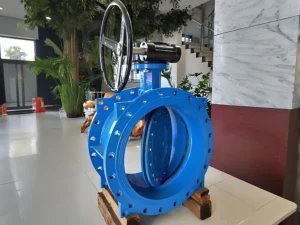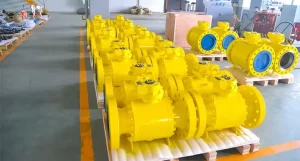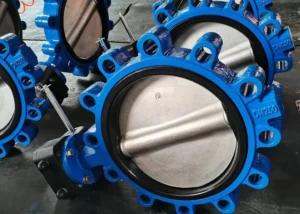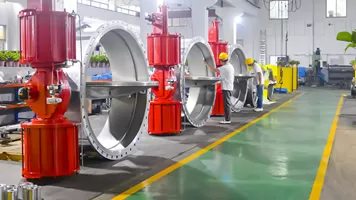I. Introduction
II. The Anatomy of Angle Globe Valves: Design Fundamentals
A. Structural Configuration
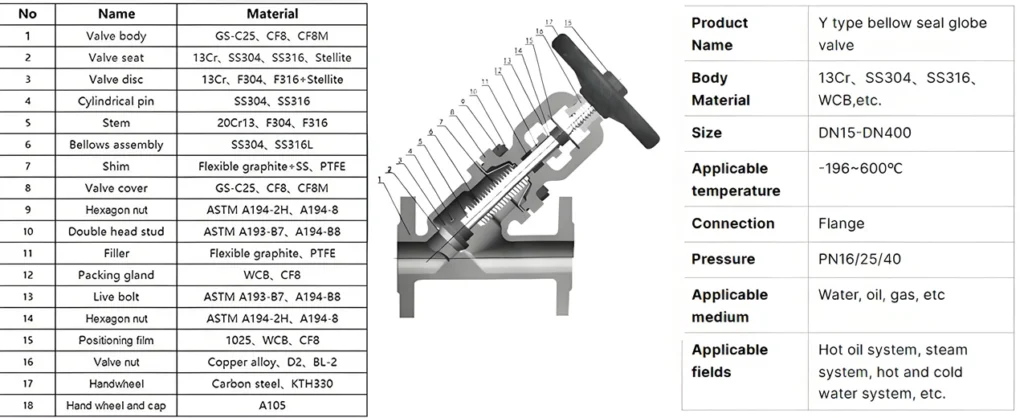
Y Type Bellow Seal Globe Valve Manual Flange and Butt Welded Y Type Bellow Seals Globe Valve
B. Flow Path Dynamics
When steam enters an angle globe valve, it encounters an immediate change in direction, transitioning from the inlet port to the valve’s internal cavity at a 90-degree angle. This angular deflection forces the steam to follow a tortuous path around the disc and through the seat, resulting in a series of velocity and pressure gradients. As the disc is adjusted along the stem, the effective flow area between the disc and seat is altered, allowing for the regulation of steam flow rate.
C. Comparison with Straight-Through Globe Valves
| Comparison Aspect | Angle Globe Valves | Straight-Through Globe Valves |
|---|---|---|
| Flow Path | 90-degree angled, promotes flow distribution and energy dissipation | Straight-line, may lead to flow maldistribution in some cases |
| Pressure Drop | Can be optimized for lower pressure drop in specific applications, but highly variable | Generally higher pressure drop, especially in high-velocity flows |
| Installation Space | Compact, ideal for tight spaces as the angled design reduces footprint | Larger footprint due to straight inlet and outlet configuration |
| Throttling Performance | Excellent for precise throttling, as the disc’s perpendicular movement allows for fine control | Good throttling capabilities, but may require more complex trim designs for high-precision applications |
| Cavitation Susceptibility | Reduced risk in some applications due to the angled flow path’s ability to dissipate energy | Higher risk in high-pressure drop applications, as the straight flow path can concentrate energy |
III. High-Pressure Drop Steam Applications: Challenges and Requirements
A. Steam Generation and Distribution Systems

Y Type Bellow Seal Globe Valve Manual Flange Y Type Bellow Seals Globe Valve
B. Process Industries: Chemical, Petrochemical, and Manufacturing
C. Critical Performance Metrics
- Pressure Drop Management: In high-pressure drop steam applications, minimizing pressure drop across the valve is crucial to reduce energy losses and maintain system efficiency. Angle globe valves are designed to achieve a balance between flow control and pressure drop, with advanced trim designs and flow path optimizations to minimize the resistance to steam flow.
- Sealing Integrity: The ability to provide tight shut-off and prevent steam leakage is essential in high-pressure steam systems. Angle globe valves employ a variety of sealing mechanisms, including metal-to-metal seats, soft seats (such as PTFE or graphite), and double-block-and-bleed configurations, to ensure reliable sealing under high-pressure and high-temperature conditions.
- Erosion and Cavitation Resistance: High-velocity steam, especially in the presence of entrained particles or contaminants, can cause erosion and cavitation within the valve. Angle globe valves are engineered with materials and surface treatments that resist erosion, and their flow path designs are optimized to mitigate cavitation by reducing pressure gradients and promoting energy dissipation.
- Flow Control Precision: Precise regulation of steam flow is often required in industrial processes to maintain product quality, optimize equipment performance, and ensure safety. Angle globe valves offer excellent throttling capabilities, allowing for fine adjustments to the steam flow rate in response to changing process demands.
IV. Technical Innovations in Angle Globe Valve Design
A. Advanced Trim Technologies
- Multi-Port and Multi-Stage Trims: To address the challenges of high-pressure drop applications, modern angle globe valves often feature multi-port or multi-stage trims. These trims consist of multiple flow passages or stages that gradually reduce the steam pressure in a controlled manner, minimizing the risk of cavitation and erosion. For example, a multi-stage trim may include a series of orifices or nozzles that progressively expand the steam flow area, reducing the velocity and pressure drop across each stage.
- Anti-Cavitation and Anti-Erosion Trims: Specialized anti-cavitation and anti-erosion trims are designed to withstand the harsh effects of high-velocity steam and entrained particles. These trims may incorporate features such as cavitation-suppressing geometries, hardened materials (such as tungsten carbide or ceramic composites), and surface treatments (such as nitriding or chromium plating) to enhance their resistance to wear and damage.
- Variable Area and Precision Trims: For applications that require precise flow control, angle globe valves can be equipped with variable area or precision trims. These trims allow for fine adjustments to the flow area between the disc and seat, enabling accurate regulation of the steam flow rate. Variable area trims may use innovative designs such as segmented discs or adjustable orifices to provide a wide range of flow control options.
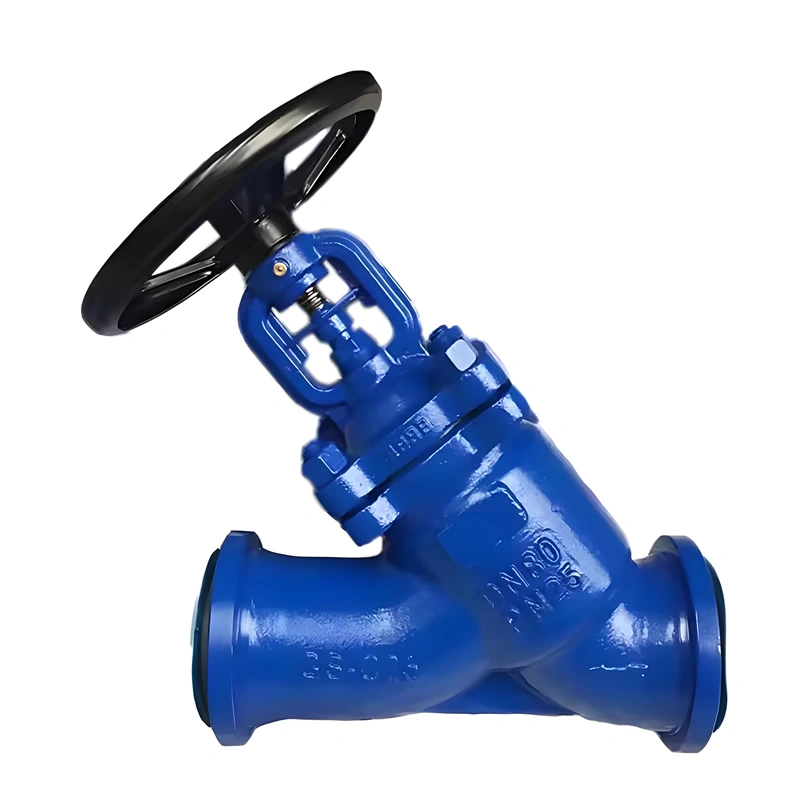
Y Type Bellow Seal Globe Valve Manual Butt Welded Y Type Bellow Seals Globe Valve
B. Material Innovations
- High-Temperature Alloys: In high-pressure steam applications, valves must be able to withstand elevated temperatures without compromising their mechanical properties or sealing performance. Advanced high-temperature alloys, such as nickel-based superalloys (Inconel, Hastelloy) and refractory metals (tantalum, niobium), are increasingly being used in the construction of angle globe valves. These alloys offer excellent strength, corrosion resistance, and thermal stability at temperatures up to 1000°C or higher.
- Corrosion-Resistant Coatings and Linings: To protect against the corrosive effects of steam and any associated chemicals or contaminants, angle globe valves can be coated or lined with corrosion-resistant materials. Common coatings include epoxy, polyurethane, and ceramic-based coatings, while linings may consist of materials such as PTFE, rubber, or glass-lined steel. These coatings and linings provide a barrier between the valve body and the steam, preventing corrosion and extending the valve’s service life.
- Composite Materials: The use of composite materials in angle globe valve construction is also on the rise. Composite materials, such as fiber-reinforced polymers (FRP) and metal matrix composites (MMC), offer a combination of high strength, lightweight, and corrosion resistance. In some applications, composite materials can be used to replace traditional metal components, resulting in reduced weight, improved energy efficiency, and enhanced performance.
C. Smart Valve Technologies
- Integrated Sensors and Actuators: Modern angle globe valves can be equipped with a variety of sensors to monitor key operating parameters such as pressure, temperature, flow rate, and valve position. These sensors provide real-time data that can be used to optimize valve performance, detect potential problems, and enable predictive maintenance. Additionally, smart valves can be integrated with advanced actuators, such as electric or pneumatic actuators with digital control capabilities, to provide precise and responsive control over the valve’s operation.
- Remote Monitoring and Control: Through the use of wireless communication technologies and industrial Internet of Things (IIoT) platforms, angle globe valves can be remotely monitored and controlled from a central control room or even a mobile device. This allows for greater flexibility in system operation, as operators can adjust valve settings in real-time in response to changing process conditions or equipment failures. Remote monitoring also enables the collection of historical data for analysis and optimization of the valve’s performance over time.
- Predictive Maintenance and Condition Monitoring: By analyzing the data collected from sensors, smart angle globe valves can implement predictive maintenance algorithms to anticipate component failures and schedule maintenance activities before they occur. Condition monitoring techniques, such as vibration analysis, acoustic emission monitoring, and thermal imaging, can be used to detect early signs of wear, corrosion, or other problems within the valve. This proactive approach to maintenance helps to reduce unplanned downtime, improve system reliability, and lower maintenance costs.
V. Selection Criteria for High-Pressure Drop Steam Applications
A. Pressure and Temperature Ratings
- Understanding ASME and ANSI Standards: When selecting an angle globe valve for high-pressure drop steam applications, it is essential to ensure that the valve’s pressure and temperature ratings comply with the relevant industry standards, such as those set by the American Society of Mechanical Engineers (ASME) and the American National Standards Institute (ANSI). These standards define the maximum allowable working pressures and temperatures for different valve materials and designs, and provide guidelines for valve selection, installation, and testing.
- Derating Factors and Safety Margins: In addition to the rated pressure and temperature, it is important to consider derating factors and safety margins when choosing a valve. Derating factors account for factors such as the effects of temperature on material strength, the presence of corrosive media, and the cyclic nature of the operating conditions. Safety margins are added to ensure that the valve can withstand unexpected pressure or temperature spikes without failure. For example, in a high-pressure steam system operating at a maximum design pressure of 1000 psi and a temperature of 500°F, a valve with a rated pressure of 1500 psi and a temperature rating of 600°F may be selected to provide an adequate safety margin.
- Special Considerations for Extreme Conditions: In applications involving extreme pressures or temperatures, such as those found in some power generation or petrochemical processes, special materials and designs may be required. For example, valves for use in supercritical steam applications, where the pressure and temperature exceed the critical point of water (3206 psi and 705°F), may need to be constructed from specialized alloys or composites with exceptional high-temperature and high-pressure resistance.

Y Type Bellow Seal Globe Valve Manual Butt Welded Y Type Bellow Seals Globe Valve
B. Flow Capacity and Cv Values
- Calculating Required Flow Capacity: The flow capacity of an angle globe valve is a critical parameter that determines its ability to handle the required steam flow rate. The flow capacity is typically expressed in terms of the valve’s Cv value, which is a measure of the volume of water (in gallons per minute) that can flow through the valve at a pressure drop of 1 psi. To select the appropriate valve size, it is necessary to calculate the required Cv value based on the expected steam flow rate, pressure drop, and other relevant factors such as steam density and viscosity.
- Cv Value Optimization and Valve Sizing: Once the required Cv value has been determined, it is important to select a valve with a Cv value that is slightly larger than the calculated value to ensure that the valve can meet the flow requirements under all operating conditions. However, choosing a valve with a Cv value that is too large can result in poor throttling performance and increased energy consumption. To optimize the Cv value and valve sizing, it is often necessary to perform detailed flow calculations and consult with valve manufacturers or engineering experts.
- Effect of Valve Trim and Configuration on Flow Capacity: The flow capacity of an angle globe valve can be significantly affected by the type of trim and configuration used. For example, a valve with a full-port or straight-through trim will generally have a higher Cv value than a valve with a reduced-port or restricted trim. Additionally, the presence of internal components such as cages, guides, or multi-stage trims can also impact the flow capacity and pressure drop characteristics of the valve. When selecting a valve, it is important to consider the specific requirements of the application and choose a trim and configuration that will provide the optimal balance between flow capacity and flow control.
C. Sealing and Leakage Requirements
- Types of Sealing Mechanisms: Angle globe valves employ a variety of sealing mechanisms to prevent steam leakage. The most common types of seals include metal-to-metal seats, soft seats (such as PTFE or graphite), and double-block-and-bleed configurations. Metal-to-metal seats offer excellent durability and high-temperature resistance, but may require higher seating forces to achieve a tight seal. Soft seats, on the other hand, provide better sealing performance at lower pressures and temperatures, but may be more susceptible to wear and degradation over time. Double-block-and-bleed configurations are used in applications where zero leakage is critical, as they provide an additional layer of protection against leakage by blocking the flow path on both sides of the valve and allowing for the bleeding of any trapped pressure.
- Leakage Classifications and Standards: The leakage performance of angle globe valves is typically classified according to industry standards, such as those set by the International Organization for Standardization (ISO) or the American Petroleum Institute (API). These standards define the maximum allowable leakage rates for different types of valves and applications, and provide guidelines for testing and certification. For example, a valve with a leakage classification of ISO 5208 Class V is allowed to have a maximum leakage rate of 0.05 mL/min per inch of valve size, while a valve with a classification of API 6D Class VI is required to have a maximum leakage rate of 0.01 mL/min per inch of valve size.
- Selecting the Right Seal for the Application: When selecting an angle globe valve, it is important to consider the specific sealing requirements of the application and choose a seal that will provide the desired level of leakage protection. Factors such as the pressure, temperature, and chemical composition of the steam, as well as the frequency of valve operation and the consequences of leakage, should all be taken into account. In some applications, a combination of different sealing mechanisms may be used to achieve the best possible sealing performance.

Y Type Bellow Seal Globe Valve Manual Flange Y Type Bellow Seals Globe Valve
D. Material Compatibility
- Steam Chemistry and Corrosion Potential: High-pressure steam can contain a variety of contaminants, such as oxygen, carbon dioxide, sulfur compounds, and dissolved solids, which can cause corrosion of the valve materials. The corrosion potential of the steam depends on factors such as its temperature, pressure, pH value, and the presence of other chemicals. For example, steam with a high oxygen content and a low pH value is more likely to cause corrosion of carbon steel valves, while steam containing sulfur compounds may be corrosive to certain types of stainless steel.
- Choosing the Right Materials for the Application: To ensure the long-term reliability and performance of an angle globe valve in a high-pressure steam application, it is essential to choose materials that are compatible with the steam chemistry and operating conditions. Common materials used in the construction of angle globe valves include carbon steel, stainless steel, alloy steels, and various non-metallic materials such as PTFE, graphite, and ceramic. The choice of material depends on factors such as the pressure, temperature, corrosion potential, and mechanical strength requirements of the application. In some cases, a combination of different materials may be used to optimize the valve’s performance and cost.
- Coatings and Linings for Enhanced Protection: In addition to choosing the right base materials, angle globe valves can be further protected against corrosion and wear by applying coatings or linings. Coatings such as epoxy, polyurethane, and ceramic-based coatings can provide a barrier between the valve body and the steam, preventing corrosion and reducing friction. Linings, such as PTFE, rubber, or glass-lined steel, can also be used to protect the valve’s internal components from corrosion and erosion. The selection of coatings and linings depends on the specific requirements of the application and the compatibility of the coating or lining material with the steam and valve materials.
The technological evolution of angle globe valves in high-pressure-drop steam control epitomizes the deep integration of extreme-condition adaptation design with revolutionary manufacturing processes. Tianyu’s Intelligent Micro Cast-Forging Technology not only resolves traditional forging pain points—giant equipment dependency, lengthy workflows, and high energy consumption—but also endows high-end valves with exceptional performance through integrated material-structure-function manufacturing.


